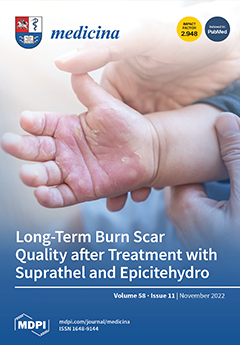Background and Objectives: Chronic severe aortic valve disease is associated with important changes in left ventricle (LV) performance associated with eccentric or concentric LV hypertrophy. We aimed to assess the immediate prognostic implications of the type of the LV diastolic filling pattern (LVDFP) compared with LV systolic performance in patients with severe aortic regurgitation (AR) undergoing aortic valve replacement (AVR) and to define the independent echographic predictors for the immediate and long-term prognoses.
Materials and Methods: We performed a prospective study enrolling 332 AR patients undergoing AVR, divided into two groups: Group A—201 pts with normal LV systolic function, divided into two subgroups (A1: 129 pts with a nonrestrictive LVDFP and A2: 72 pts with restrictive LVDFP), and Group B—131 pts with LV systolic dysfunction (LV ejection fraction LVEF < 50%), divided into two subgroups (B1: 83 pts with a nonrestrictive LVDFP and B2: 48 pts with restrictive LVDFP).
Results: The early postoperative mortality rate was higher in patients with a restrictive LVDFP (11.12% in A2 and 12.5% in B2) compared with normal LV filling (2.32% in A1 and 7.63% in B1,
p < 0.0001), regardless of the LVEF. The restrictive LVDFP—defined by at least one of the following echographic parameters: an E/A > 2 with an E wave deceleration time (EDt) < 100 ms; an isovolumetric relaxation time (IVRT) < 60 ms; or an S/D ratio < 1 in the pulmonary vein flow—was an independent predictor for early postoperative mortality, increasing the relative risk by 8.2-fold. Other independent factors associated with early poor prognosis were an LV end-systolic diameter (LVESD) > 58 mm, an age > 75 years, and the presence of comorbidities (chronic obstructive pulmonary disease-COPD or diabetes mellitus). On a medium-term, an unfavorable evolution was associated with: an age > 75 years (RR = 8.1), an LV end-systolic volume (LVESV) > 95 cm
3 (RR = 6.7), a restrictive LVDFP (RR = 9.8,
p < 0.0002), and pulmonary hypertension (RR = 8.2).
Conclusions: The presence of a restrictive LVDFP in patients with AR undergoing AVR is associated with both increased early and medium-term mortality rates. The LV diastolic function is a more reliable parameter for prognosis than LV systolic performance (RR 9.2 versus 2.1). Other independent predictors for increased early postoperative mortality rate were: an age > 75 years, an LVESD > 58 mm, and comorbidities (diabetes mellitus, COPD), and for unfavorable evolution at 2 years postoperatively: an age > 75 years, an LVESV > 95 cm
3, and severe pulmonary hypertension.
Full article






